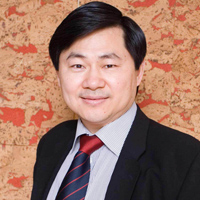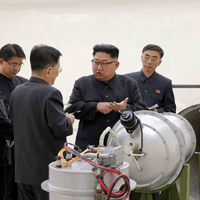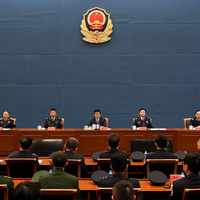-

[China Daily] Wang Huiyao: Policies key to bringing talent home
The report delivered by General Secretary Xi Jinping to the 19th National Congress of the Communist Party of China (CPC) in October emphasized that talent is a strategic resource for national rejuvenation and international competitiveness.Outstanding students who return to China after studying abroad with advanced knowledge and skills are representative of this talent pool.Overseas students have played a pivotal role in China’s modernization since the founding of the People’s Republic of China, especially at the beginning of reform and opening-up in 1978.The status of Chinese overseas students has changed significantly after 40 years of development.In 2017, a record 480,900 overseas students returned to China. By the end of 2017, the total number of Chinese studying abroad was around 5.2 million. It is expected that around 3.1 million will choose to return to China after finishing their studies, accounting for 83.7 percent of those who successfully complete their studies.Since the 18th CPC National Congress in 2012, the number of overseas students returning has continued to climb, reaching a total of 2,231,600. This accounts for more than 70 percent of the total number of returnees since the start of reform and opening-up.A range of social and policy factors have helped form this wave of overseas students returning to China, including a desire to reunite with family, employment pressure overseas and the growing opportunities to be found in China, especially in recent years.Government support for employment and entrepreneurship for returned overseas students has also contributed to the tide.Family reunion is a major reason for overseas students returning to China. Given China’s economic development and aging population, for overseas students, especially those who are an only child, feelings of familial responsibility are often a major factor in the decision to return home.In addition, Chinese students overseas are finding it more difficult to secure jobs, as some countries have tightened rules on employment and the status of overseas students in recent years, while at the same time such students are at a disadvantage because they know less about the local environment and labor market.Other factors that have prompted overseas students to return to China include the limited space for career progression, pressures of life abroad and safety issues.“Pull” factors persuading students to return to China include the great potential for career development at home and supportive policies. The government has intensified efforts to encourage innovation and policy support for returned students.Since Premier Li Keqiang launched the mass entrepreneurship and innovation initiative, all levels of government in China have increased the support for small and micro enterprises, mass entrepreneurship and innovation.This has made many overseas students enthusiastic to return home to seek opportunities for entrepreneurship and employment. In turn, business success stories of students who have returned to China encourage more overseas students to follow this path.At the national level, there is the Thousand Talents Plan and the Ten Thousand Talents Program; at the local level, there are programs such as Beijing’s Overseas Talent Aggregation Project and Shenzhen’s Peacock Plan.Under new policies, overseas students can qualify for tax-exempt car purchases, eased settlement and residence, benefits regarding employment and entrepreneurship funding, and preferential policies for academic research and entrepreneurship.While the government has created sufficient policy conditions to encourage overseas students to return to China, in the future, we should work harder to improve the level of government services to better attract and retain talent.To attract overseas students back to China, in addition to optimizing the overall environment to nurture talent, government services for employment and entrepreneurship should be fine, deep and detailed.Many localities provide customized services tailored to overseas returnees at different stages of development.For example, a product marketing service center for the Thousand Talents Plan has been established. It offers policy information, entrepreneurship training and management consulting, as well as platforms for interactive communication and the commercialization of innovation.For enterprise development, we encourage and provide some funding for high-level talent to take on leadership roles like organizing international academic conferences and seminars. We also try to resolve practical difficulties, such as providing preferential treatment for high-level talent in areas such as immigration and medical care.At the same time, we should improve the financial system to resolve challenges that overseas returnees face. This includes expanding financing channels such as establishing innovation funds for overseas students, direct subsidies, low-interest loans and venture capital funds.This will help nurture a generation of returnee-led businesses that possess intellectual property and bright market prospects. We must also work to build and refine an assessment and guarantee mechanism for technology companies, encouraging venture capital investment in new projects and enterprises.Governments at all levels must not only formulate policies, but also work to ensure the full implementation and effectiveness of these policies.It is also important to absorb feedback from returned students on these policies and to better understand their actual needs regarding entrepreneurship and employment. This will help to unlock the vast potential of returned students in supporting modernization in the new era.About Author Dr. Wang Huiyao is president of the Center for China and Globalization(CCG), the largest independent think tank in China, with over 100 researchers and members of staff.From China Daily,2018-5-28
2018年5月30日 -
冷炎:中国企业走出去要有开放的胸怀
凤凰网财经讯5月20日,由全球化智库(CCG)主办的第四届中国与全球化论坛在北京银泰中心举行,本届论坛主题为“互塑和推动——改革开放与全球化的新未来”。凤凰网财经全程直播。 戴姆勒大中华区投资有限公司执行副总裁冷炎在论坛上表示,吉利控股集团董事长李书福之所以收购奔驰母公司戴姆勒9.69%股权是因为中国已经成为戴姆勒集团在全球范围内最大的单个市场。2017年戴姆勒在中国国内销售61万辆,美国是34万辆,德国是29万辆。原来排名是美国、德国、中国,现在中国远远比他们甩在后面了。因为中国2016年的时候是47万辆,2017年是61万辆,每年增长超过25%,2018年这个销售数字还要更高。 冷炎称中国市场对戴姆勒非常重要,所以戴姆勒必须要考虑怎么在中国市场更好的符合政府规划,跟着中国市场一起增长。 以下是冷炎发言实录: 李书福前一阵子通过几个公司一下子入股戴姆勒集团9.7%的股份,他目前应该是最大的股份持有人。戴姆勒集团除了大家熟悉的奔驰乘用车就是轿车以外,它也是世界上最大的重型卡车的供应商。这个题目叫“一带一路”,我想如果要说到戴姆勒公司,我们是在中国有大量的投资,对中国政府现在推行的走出去的战略方针我们也是一直想找到一个契合点。所以我们现在借助“一带一路”,更多的是通过我们合资企业提供的重型卡车,而跟随着中国基础设施项目走到邻近的这些国家。同时我们直接参与了中欧铁路,原来我们的零配件都是海运的,现在中欧铁路前一阵子面临的问题就是出去的多,回来的经常空运或者运量不足。我们在成都当地通过对“一带一路”从欧洲回来的货物特殊的关检,提供了很多优惠,我们也参与了其中,其他也都有公司参与。 我想这个可能和其他国内,不管从投资,包括从参与基础设施项目的一些公司来讲,这个我们“一带一路”的参与程度还没那么大。但是我想借今天这个话题,以“一带一路”促全国开放新格局提一下,在博鳌以后,在汽车行业,尤其在国内有些新的政策已经宣布不久要实施,包括以前对外资的50对50的限制,包括对外资2+2的限制,合资的伙伴,这个对汽车行业影响很大。现在戴姆勒在中国的业绩,为什么李书福入股?就是因为中国已经成了戴姆勒集团不仅在海外,在全球最大的单个市场。可能有些数据我给大家一讲大家就明白中国市场对戴姆勒的重要性。戴姆勒2017年在咱们国内的销售一共是61万辆,大家可能对这个数字没有什么太大的感受。我给大家介绍一下美国是多少,以前美国是最大的市场,美国是34万辆,德国是29万辆。原来排名是美国、德国、中国,现在中国远远比他们甩在后面了。因为中国2016年的时候是47万辆,2017年是61万辆,每年增长超过25%,2018年这个数字还要高。我说这些的意思就是,中国市场对戴姆勒的重要性,所以戴姆勒必须要考虑,怎么在中国市场更好的符合中国政府计划和规划,我们能够相适应,这样的话才能够跟着中国市场一起增长。 讲到全面开放的新格局,现在我们每年汽车的产量是2900万辆,近3000万辆,有很多人说这个市场慢慢就要饱和,尤其是中国在新能源汽车方面,现在致力于引领世界制定规范,不仅仅是电动车,包括将来智能网联。我想如果要吸引更多的国家参与“一带一路”,尤其是西方国家,肯定我们在国内,在新能源汽车方面,在制定标准方面也要拥有胸怀,要允许其他国家参与。因为从汽车行业来讲,中国市场发展这么快,也要面临走出去的那一天。现在我们的乘用车还不是“一带一路”走出去主要的产品,但是这个按照中国市场的发展速度来讲也会很快。所以在国内市场新的布局,在新能源汽车方面,在标准规范制定方面,能够更多的邀请国外企业一起参与,这样不至于自己搞一套。自己搞一套的后果是将来你走出去,别人也不认可你。所以我要讲的意思就是,为今后汽车行业走出去,走到“一带一路”,加入“一带一路”长期的计划,现在在国内市场开放方面,也是我们一个大的趋势,要吸纳各国参与,你这个标准最好是大家认可,你这个规范也是大家都同意的,这样你才能真正做到在规范标准方面是一个引领者,是有大家支持的。选自凤凰财经,2018年5月20日
2018年5月29日 -

【CGTN】Shou Huisheng: The long road towards denuclearization in DPRK
The drama surrounding the June 12 Trump-Kim summit, with Trump abruptly canceling the meeting on May 24 and then, within 24 hours, tweeting about the possibility of it actually going ahead, is truly stunning by any measure.A man reading a newspaper at Seoul railway station on May 25, 2018, Seoul, ROK. /VCG PhotoOne can only guess what was behind this drama. The Kim government is relatively clear in its intention and strategy. It was, as usual, trying to gain a better position during the bargaining. After all, being the weaker party, it doesn’t possess enough leverage to go against the US other than showing its strong stance and willingness to play without following rules.Retrospectively speaking, it would be unusual if Kim Jong Un did nothing but let the meeting go smoothly without last-minute bargaining. But Kim’s intention for talk is clear. As some of my colleagues predicted a year ago, once the DPRK’s nuclear capacity reached a certain level for the government to be able to bargain with the US, the DPRK would change its rhetoric and instead portray itself as a peace lover. That, as shown by the DPRK’s statement responding to Trump’s cancellation letter and Kim’s second meeting with President Moon of S. Korea on May 26, is precisely what is happening.ROK President Moon Jae-in (L) shakes hands with DPRK leader Kim Jong Un during their second summit at the north side of the truce village of Panmunjom in the Demilitarized Zone (DMZ), on May 26, 2018. /VCG PhotoOn the other hand, as many predicted correctly as well a long time ago, the greatest uncertainty rests on the US side. Even though Trump insisted that there was no internal divide in the White House, his eagerness for the talk before and after issuing the cancellation letter and his ambiguous language in the letter all show that he was not likely to use the letter to gain any leverage against Kim. Rather, he was not capable of controlling his own team.A year ago, I wrote to warn that uncertainty created by Trump’s erratic behavior and his inability to control his decision-making process would put Kim in a difficult position to make a compromise. Now the situation for Kim has changed and he is willing to negotiate. But Trump’s problems remain and only put him in an awkward position.The bottom line is that we are in a bizarre situation where two men play games without agreeing what the rules are. For a difficult case like the current one, giving the leaders enough space for free thinking and bold action without being bound by political correctness may not be a bad thing. Hopefully, the chaos within the Trump administration would not create new problems as the two sides seem willing to grasp the slim chance to hold the scheduled summit.DPRK leader Kim Jong Un shakes hands with US Secretary of State Mike Pompeo in this May 9, 2018 photo released on May 10, 2018, by the DPRK’s Korean Central News Agency (KCNA) in Pyongyang. /VCG PhotoThus a natural question is in order: even if the meeting will be held on June 12, given what has happened, what should we expect after it has ended? It is difficult to imagine the precise scenarios that may occur but one can safely predict, particularly for now, that more troubles will follow. The denuclearization in DPRK is doomed to be a long and arduous road and it would be foolish for anyone to give a simple answer about the future.Chinese President Xi Jinping (R2) and his wife Peng Liyuan (R1) meet with DPRK leader Kim Jong Un (L2) and his wife Ri Sol Ju at the Great Hall of the People in Beijing during Kim’s visit to China from March 25 to 28, 2018. /Xinhua PhotoA silver lining for this gloomy situation is that S. Korea, China and Russia could play a more positive and active role in putting the negotiation between Trump and Kim into a more structured format so that anything like what has happened can be managed. It is anybody’s guess what role China has played in the past few days and how much it contributed to the situation. But the fact that Trump repeatedly expressed his appreciation for President Xi Jinping’s assistance suggests that the US wants China to be more helpful in solving the problem. Mr Trump should do more to avoid conflict with China at this moment – particularly on trade issues – if he wishes for a more predictable future.That wouldn’t change the fact that the internal dynamics in the White House ultimately determine the outcome. By adding an extra layer of constraint from outside, nevertheless, can greatly assist every actor involved in better understanding each other and therefore behaving more rationally.After all, it is a great power struggle that has allowed the situation to develop to where it is today. In this critical moment, therefore, it is more important than ever for the great powers to work together to solve this problem.About Author Shou Huisheng is a senior fellow with Center for China and Globalization(CCG) and a researcher at Tsinghua University’s National Strategy Institute .From CGTN,2018-5-28
2018年5月29日 -

【China Daily】Wang Huiyao: Trade deal offers new vistas for Sino-US ties
Illustration: Liu Rui/GTThe agreement between China and the US to end a trade confrontation sent ripples of relief across the world and is a valuable opportunity for ties to take a new direction.In 2017, China and the US together accounted for 40 percent of the global economy and over half of global growth, a testimony to the importance of ending a trade crisis and looking ahead. Given the importance of the May 19 agreement, both sides have a responsibility to seize the opportunity and take proactive steps to foster new areas of cooperation. Thus, economics and trade can again become the bedrock of bilateral ties, rather than a point of friction.To meet the growing needs of Chinese consumers and support quality development, China has committed to increasing purchase of US goods, particularly agricultural products, energy and other quality products and services. Both sides will also explore ways to encourage bilateral investment. Drawing on in-depth research on Sino-US economic relations by the Center for China and Globalization (CCG), this article outlines four promising areas based on the consensus achieved in Washington. First, services. Services play an important role in balancing Sino-US economic relations. New WTO data show that the US ran a surplus of $54 billion in trade in services with China in 2016, a 33-fold rise over the preceding decade. Given rising incomes and demand for quality services in China, there is considerable room for further growth in Sino-US trade in services, particularly in tourism, education, and cultural products.Take tourism, which accounts for over half of US service exports to China. A recent report by CCG found that in 2016, the number of visits to the US by Chinese tourists grew 15 percent to almost 3 million, with associated spending in the US up 9 percent to around $33 billion. Deeper bilateral cooperation on services trade will not only help reduce the trade deficit, but also increase opportunities for exchange and mutual understanding. Second, e-commerce. The rising spending power and evolving preferences of China’s 400 million-strong middle class present major opportunities for US exporters. Online shopping is the most striking reflection of this growing market. Spending by Chinese consumers during last year’s annual November 11 online shopping spree reached $40.5 billion in a single day, and trade via China’s cross-border e-commerce (CBEC) platforms has grown at over 50 percent annually for the last three years. Both sides can help unlock the CBEC potential to connect this growing market with US companies both large and small, by pursuing a bilateral CBEC agreement that allows for coordination on relevant standards and trade facilitation measures. This would give Chinese consumers access to a wide range of quality products while helping reduce the trade deficit and creating opportunities for employment, innovation and investment in both countries.Third, energy. Current trends are conducive to growing energy trade between China and the US in the coming years and decades. It is only a matter of time before China surpasses the US to become the world’s largest energy consumer and imports account for over half of China’s energy use. Beijing’s efforts to tackle air pollution and shift to cleaner fuels will drive demand for gas imports in particular.Meanwhile, the shale revolution means that the US is expected to become a net energy exporter by 2022. This represents a major shift in the global energy sector and China is the ideal market to absorb rising US exports. In 2017, China was importing 220,000 barrels of crude oil per day from the US. There is potential for US energy exports to China to rise significantly in the coming years. Chinese capital can also help resolve midstream infrastructure bottlenecks in the US that currently limit the growth of energy exports. Fourth, infrastructure cooperation. There are many other opportunities for Sino-US collaboration in infrastructure. President Trump’s $1 trillion infrastructure initiative calls for major investment in transport networks, water supply, communications and power grids. China’s accumulated capital and infrastructure knowhow can contribute to this program. To achieve this, Sino-US dialogue spanning policy, finance and industry will be needed to devise innovative models for collaboration that can help overcome potential political resistance and meet requirements to use US homegrown products. Leveraging Sino-US synergies in infrastructure cooperation will not only create jobs and help boost US exports, but can also build momentum for cooperation in other areas. The recent bilateral agreement has opened new vistas for mutually-beneficial cooperation between China and the US. To take full advantage of this opportunity, fresh ideas and deeper bilateral exchange are needed to forge new modes of cooperation. In addition to high-level government-to-government dialogue, businesses, think tanks and citizens of both countries also have an important role to play in this process. As an independent Chinese think tank, the CCG strives to play a role in Sino-US relations by providing a platform for people-to-people diplomacy and exchange of ideas. We hope that Chinese and US policymakers will fulfill their responsibility to the citizens of both countries and the rest of the world by avoiding the trap of zero-sum thinking and working to nurture shared interests and mutual trust. This will provide a foundation for stability and prosperity as we open a new chapter for Sino-US relations. About Author Dr. Wang Huiyao is president of the Center for China and Globalization(CCG), the largest independent think tank in China, with over 100 researchers and members of staff.From Global Times,2018-5-27
2018年5月29日 -

【凤凰周刊】成立国家移民管理局: 中国强势加入全球人才争夺战
2018年4月2日,公安部召开国家移民管理局成立大会。国务委员、公安部党委书记、部长赵克志出席并讲话。 近日,中国国家移民管理局成立并挂牌。 根据今年两会期间的国务院机构改革方案,为加强对移民及出入境管理的统筹协调,更好形成移民管理工作合力,将公安部的出入境管理、边防检查职责整合,建立健全签证管理协调机制,组建国家移民管理局(加挂出入境管理局牌子),由公安部管理。 其主要职责是,协调拟定移民政策并组织实施,负责出入境管理、口岸证件查验和边民往来管理,负责外国人停留居住和永久居留管理、难民管理、国籍管理,牵头协调“三非”(非法入境、非法居留、非法就业)外国人治理和非法移民遣返,负责中国公民因私出入国(境)服务管理,承担移民领域国际合作等。 中国公安部新闻中心向《凤凰周刊》介绍,此次组建国家移民管理局、改革完善移民和出入境管理体制,是深化党和国家机构改革的重要组成部分,是推进国家治理体系和治理能力现代化的一场深刻变革,是大势所趋、时代所需,将服务国家发展大局,展现自信开放中国。 全球化智库(CCG)主任王辉耀表示,国家移民管理局成立象征着中国为吸引国际人才提供制度性支持的努力,是中国改革开放的新标志。同时,也显示中国将规范国际移民管理,包括对“三非”和可能出现难民的管理。 中国官方媒体《人民日报》也撰文称,“最近这轮党和国家机构改革中,组建国家移民管理局被视为中国开展全球人才竞争的顶层设计。” 今年3月9日,上海市公安官网曾发布一条《关于印发<上海市常住户口管理规定>的通知》,其中第四十六条提到“出国定居或者加入外国国籍的,本人应当向户口所在地公安派出所办理注销户口登记”。该条款还补充提到,在公安派出所通知后拒绝注销、或者一个月内仍未办理的,将被强制注销户口。该“户口新规”将于2018年5月1日生效。 消息一出,立刻引发海外华人、华侨的关注和热议。 “大家都在看呢。不管是入籍的,还是拿绿卡的,我周围人的国内户口能留的基本都留着呢。周围人一百个听说了,几乎一百个反对。”林涛(化名),35岁,上海人,初中毕业后,就随父母闯荡到英国投奔亲戚,做小生意为生,多年前加入了英国籍,但他们还一直保留着上海的户口和房子。 长期以来,像林涛这样已经取得外国国籍,同时私下维持国内户口的,不在少数。然而,根据中国有关法规的规定,中国公民加入外国国籍后,就会自动失去中国国籍。上海市公安局的上述规定,只是将此规定进一步明确和细化,挤压了国籍和户籍制度的模糊空间。 除了已经入外国籍者,对于获取了海外永久居住权的中国公民而言,在网络上不少人都将其解读为“外国绿卡和上海户口二选一”。 “各种关于户口的传言给人的感觉就是,政府并不欢迎我们回去。”Alice(化名)老家在湖南长沙,2011年取得澳大利亚绿卡,在悉尼市某网络公司担任工程师。 她担心,上海的政策可能扩大到全国各地。一旦失去中国户籍,就会波及中国的身份证、驾驶证、银行开户、股票基金、机票火车票购买、酒店入住、婚姻登记等等,可能都会变得程序繁琐,甚至无法办理。 Alice说,她至今还没有入籍澳大利亚,就是因为这些问题。“菲律宾朋友说,他们也不承认双国籍,但至少可以保留出入自由,国家保留他们的居民权。” 李丹(化名)在华南某城市政府部门从事人才工作,当地高新产业近年招引了不少海外人才,他们有的保留着中国国籍和户口,同时拿到了美国绿卡,这样两边的便利就可以都享受到。“取消掉他们的户口,他们在国内创新创业肯定就不太方便。”她也担心自己城市的人才招引未来可能受影响。 相较海外华人的反应,中国国内一些评论截然不同,有网友批评“两头捞好处”。 早在2003年,公安部就明确规定:出国、出境1年以上的人员可以不注销户口,但是在国外、境外定居的应当注销户口。 有评论称,户口是中国政府管理常住人口,分配经济、教育、卫生等公共资源的基础性制度。长期定居海外的人士如果也参与资源分配,对其他国人是一种不公平。 3月25日,上海公安局官方微博“警民直通车-上海”发文称,鉴于目前《中华人民共和国出境入境管理法》的实施细则尚未制定,关于出国定居的法定内涵尚不明确具体,因此,现阶段上海公安机关对出国定居人员不注销户口。 沸沸扬扬的上海户口风波至此总算告一段落。 王辉耀表示,像林涛等海外华人遇到的问题,用“华裔卡”就能解决。 为了让海外华人回国更加方便,中国政府今年2月专门推出了“准绿卡”新政:对在当地工作、学习、探亲以及从事私人事务需长期居留的外籍华人,公安机关出入境管理机构可按规定签发有效期5年以内的居留许可。 “把这个签证改成一张卡,就是‘华裔卡’”。王辉耀建议,国家移民管理局成立后,可以正式推出“华裔卡”,再将有效期延长到10年甚至20年,而且可以学习印度的“印裔卡”,四代之内都可以申请。 “海外华人有6000万,一旦改善政策,中国参与推动全球化的进程将会大大加快,他们往返中外,创新创业等会大大活跃,投资也会增加,从而推动‘一带一路’和中国发展。”他介绍,印度给海外印度人发行了上千万张“印裔卡”,持卡人除了没有政治权利,能享受几乎所有便利,比如在印度居留、就业、买房、上学等等。 近几十年来,发达国家一直在享受移民红利。更富冒险精神的移民人才是发达国家创新创业的重要力量。 20世纪90年代,移民对新加坡GDP增长的贡献率一度超过40%。在美国,移民获得的创新专利量占据了总量的1/3,1/3的诺贝尔奖获得者是移民。移民创建了美国占总量1/4的高科技公司,美国市值前50名的上市公司中,有近一半是移民创建或共同创建的。在美国科学与工程领域拥有博士学位的就业者中,外国人比例从1993年的23%增至2010年的42%。 王辉耀介绍,当前,世界经济发展面临新的挑战,上一轮科技进步带来的增长动能逐渐衰减,新一轮科技和产业革命正在形成势头。而且全世界新一轮的高科技,AI、大数据甚至区块链的竞争其实就是对高端人才的竞争。美国培养了全世界40%的诺贝尔奖获得者,但全世界60%以上的诺奖获得者都在美国工作。相比之下,在中国工作的诺奖工作者寥寥无几。 因此,各国纷纷出台各种措施,吸引外国人才为本国经济、社会发展增添活力。世界范围的“人才战争”愈演愈烈。 “全球贸易战的背后,是各国对新科技革命和产业升级的白热化竞争。特朗普对部分移民加强限制,但是对美国急需的人才其实竞争更激烈了。”王辉耀说。 根据联合国报告,2015年世界跨国流动人数达到2.44亿,其中71%流向高收入国家,72%为20岁至64岁工作年龄段的劳动力。 随着人口老龄化的加深,中国人口红利逐渐消失,如果没有很好的机制和政策来吸引国际人才,将坐失国际人才潮涌的新红利。 按联合国2015年《国家移民存量倾向》报告,居住在中国的外国国籍人口为97.8万(其中很大比例是华人),占总人口的比例为0.07%,在全世界200多个国家和地区中,排名倒数第六,远低于发达国家和地区的平均水平10.8%,低于世界平均水平3.2%,甚至低于最不发达国家的平均水平1.2%,低于人口规模相当的印度的0.4%。被认为“非常不欢迎外国人”的日本也有200多万外国常住人口。 据美国国土安全部数据,2014年美国共颁发绿卡101.65万张。仅次于美国的第二大移民流入国为德国,2014年接受57.45万新移民。中国自建立绿卡制度以来,发放总量1.2万张左右,不及美国一年发放的零头。根据经济合作与发展组织发布的《2016国际移民展望》,2014年中国仍是最大的移民来源国,移民海外人数达到55.5万人。 从城市看,美国硅谷的外国人才比例为40%,伦敦、纽约、悉尼和多伦多等也有约三分之一是外国裔。而同样以创新创业为基调的北京中关村,外国人才比例不足1%。 中国招才引智已是刻不容缓。 今年2月,中国驻英国大使馆官网曾发布紧急提醒,直指部分已加入外籍并且持有中国签证的申请人涉嫌骗取中国护照。 林涛认为,一些英籍华人骗取中国护照,不排除有违法犯罪意图,但也有的是贪图便利。“我和英国朋友聊天,说起我回中国要办签证,大家都觉得不可思议,他们不理解中国人回自己国家还要签证。而且,办签证涉及预约、排期等,预约7-10天,办理后再等3-5天。签证费也比较贵,之前要200多镑签一年,现在是50-149镑不等。” 移居澳大利亚的Alice同样面临着生活不便问题。她现在最烦心的是国内的户口怎么处理,Alice曾在成都上学和工作,户口一直挂在四川省人才市场,每次回去就要补管理费,但一直没时间转回老家长沙。 Alice的中国身份证也已经到期,但是中国驻澳大利亚大使馆不能续办,必须本人回原派出所(成都)办理。因为没有合适的时间回去办理和等待,也只好不了了之。 “上次回国,打算买张手机卡,老板说用身份证买当场就能买能用,用护照买要等一个月。买高铁票要用身份证,可以用身份证直接登车,护照不行,一切要去柜台办理,不能网上办。”Alice在中国的生活已开始面对诸多不便。 除了上述移居海外的华人,外国人来华工作、生活也遭遇各种瓶颈。 目前,外国人才出入境和居留的行政手续还比较复杂,移民局成立前,签证、居留、就业、入籍都由不同的部门管理。 比如,境外人才来华就业,需要就业许可证书、就业证(专家证)和居留许可三个证件齐全,分别由劳动主管部门、行业主管部门和外国专家主管部门、公安部门颁发,职能交叉和重叠现象导致程序繁杂。另外,三证有效期限不统一,且居住证和就业证必须在过期前一个月才允许申办。 相比之下,美国仅需劳工部审批聘雇外国人劳动力市场测试,并发放外国人工作许可即可。 再如“绿卡”申请,需要提供大量证件、材料,缺少一份就可能申请失败。一些材料却不符合外国惯例,有外国人就发现无犯罪记录证明在自己国家并不容易开具。 “中国绿卡很难拿,我们工作中体会特别深,而且权限在很高的部门,在国家层面,省里和市里都没办法。”从事人才招引的李丹说。 更关键的是,中国尚未建起留学、签证、绿卡、入籍之间的衔接机制。 按照现行规定,外国留学生毕业后,必须在规定时间内出境,而就业证要求具备2年工作经验。直接毕业没有工作经验的留学生无法办理工作签证,寻找工作没有缓冲期。同时,未取得居留证件的外国留学生不得在中国实习。学习签证转工作签证需要出境办理;工作签证办理限制多、程序复杂,国内有些公司因此不愿办理。 “相反在国外,通过完善的国际教育体系、留学签证和各种留学政策吸引国际留学生,并完善留学签证与工作签证的衔接,留住外国优秀留学生,已成为各国开发外籍人才的一个主要战略。”王辉耀表示,所有这些问题都急需设立移民管理局来解决。 移民局可以更好地为移民和居民出入境提供便利服务。在发达国家和地区,外籍人才办理证件都是由一个专门的政府部门受理,如美国有公民与移民服务局(USCIS),澳大利亚有移民和公民部(新近并入内务部),日本有厚生劳动省,韩国有就业和劳工部。 专门的移民局可以统一管理外国人签证、居留、移民等事务,统一审批绿卡和入籍申请,处理之后的社保、档案、集体户口等问题。在语言培训、文化融合、提供职业信息等方面也可以发挥重要作用。 今年两会期间,国务院机构改革方案提出,组建国家移民管理局。4月,国家移民管理局正式成立。 中国公安部新闻中心向《凤凰周刊》表示,此次组建国家移民管理局,并加挂出入境管理局牌子,有利于整合分散于多个部门的移民和出入境管理职能,加强对移民及出入境管理的统筹协调,更好地形成工作合力;有利于提高对各类违法犯罪行为的防范和打击能力,筑牢国门安全屏障;有利于简政放权、创新管理,提高移民和出入境管理服务水平。同时,不断完善移民管理政策,优化移民管理服务,畅通引才引智渠道,向全世界释放吸引高端外籍人才和投资者来华工作、生活的积极信号,更好地服务国家经济发展战略和对外开放新格局。 王辉耀介绍,移民管理局的建立也将使中国与联合国国际移民组织在机构设置和运作中更好对接,和其他国家的移民局也可对口合作,借鉴国际上人口流动的先进管理经验。 2016年6月,中国正式加入国际移民组织,结束了15年的观察员身份。作为观察国,中国参与移民领域全球治理的深度和话语权远远不够,也不利于移民问题的国际协调。 同年9月,联合国时任秘书长潘基文和国际移民组织总干事斯温签署协定,国际移民组织加入联合国系统。 在联合国框架内,中国可以更广泛参与到移民领域全球治理的决策和行动中,提升在该领域的国际话语权。 “加入国际移民组织和当年加入WTO是类似的,一个是货物流动,一个是人口流动。过去几十年,中国发展劳动密集型产业,货物流动就非常重要。现在转向高质量发展和新经济,人才争夺、人才流动就变得非常突出了。” 王辉耀建议,以移民局新设为契机,下一步要积极推进探索移民法,以及技术移民、投资移民与积分制的相关政策措施,在宏观上营造吸引外国人才移民的环境氛围。未来移民管理局还可承担国际人才信息库、海外国家猎头、国际人才研究和管理好“三非”和难民的功能等职责。 目前,公安部同时管理国际流动人口和国内的3亿左右流动人口。加入国际移民组织,成立移民管理局会促进国内人口流动更加开放,也会像加入WTO促进货物流动一样,促进中国相关改革,更好学习国际先进经验,对服务国内流动人口将会产生推动作用。 “现在是二元待遇,教育、医疗等公共服务相差较大,很不公平。我们需要提升我国流动人口的管理经验和服务水平。南方一些省市已有探索,如广州成立的来穗人员工作局,不分国际、国内流动人口都同时管理,运转服务得很好。”王辉耀说。文章选自凤凰周刊,2018年5月5日
2018年5月29日 -
崔大伟:中国在流动人才引进方面存在三个主要障碍
崔大伟,CCG国际顾问委员会顾问、香港科技大学中国跨国关系中心主任 2018年5月20日,由全球化智库(CCG)主办的第四届中国与全球化论坛在北京银泰中心举行。在“全球化新秩序——中国可以为世界做什么?”分论坛上,香港科技大学人文与社会科学院副院长崔大伟就“流动人才”话题,同与会来宾分享观点。 崔大伟在发言中表示,流动人才步入市场,首先要做的是找准市场需求,成为市场需要的人才。他指出,出国留学的人员留学时间越长,拿到的学位越高,对国际问题的理解越深刻。他认为,“千人计划”是一项好政策,可以为中国带来国外先进的、全球化的科技技术。 崔大伟指出,中国在流动人才引进方面存在三个主要障碍:第一,在科研方面,国外留学回来的学者与国内学者之间的存在不平衡性;第二,国外留学人员深受外国意识形态的影响,与国内存在差异;第三方面是知识产权的问题。文章选自人民网,2018年5月20日
2018年5月28日 -
梁建章:人才观念的根本是以人为本
梁建章,全球化智库(CCG)资深副主席、携程联合创始人、执行董事局主席。2018年5月20日,由全球化智库(CCG)主办的第四届中国与全球化论坛在北京银泰中心举行。在当日举行的“人本全球化的中国推动”分论坛上,携程联合创始人、执行董事局主席、CCG 资深副主席梁建章表示,人才观念的根本是以人为本。 梁建章表示,对外交流可以通过贸易和产品实现,但更重要的是人与人之间的交流。中国在这方面还有政策提升空间,为外国人到中国来工作创造各方面的条件。比如携程现在也在做全球化,我们现在不光要服务中国人,还需要把携程旅游服务推广到其他国家,包括英语国家、拉美的、亚洲国家(日韩方面的客人),我们在推广当中要建立地区总部、营销服务中心,不同语言的人才需要招进来。 梁建章说,欧洲的总部是在伦敦,因为伦敦有欧洲各种各样的人才。美洲的总部就可以放在美国,因为美国虽然是英语国家,但西班牙语、葡萄牙语也能全覆盖,但亚太总部问题,发现最后讨论下来大家觉得上海不太适合。因为上海不像新加坡和香港有各种各样的国外人才。上海是中国最大的国际大都市,但对外国人的吸引力还是不如香港和新加坡。梁建章认为,中国人才国际化整体有很大的提升空间。环境问题、房价问题和签证便利性等都是影响国际人才吸引力的因素。 梁建章表示,人才观念的根本还是以人为本,要让各种福利、各种设施跟着人走。如果真正做到这一点,让包括农村人口、大学生以及外国人在内的每个人的存力充分发挥出来,中国能成为一个真正的强国。 文章选自人民网,2018年5月20日
2018年5月28日